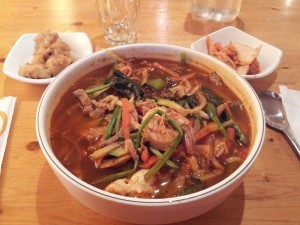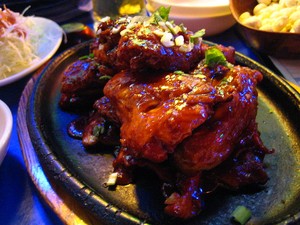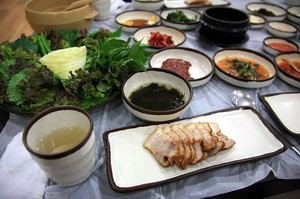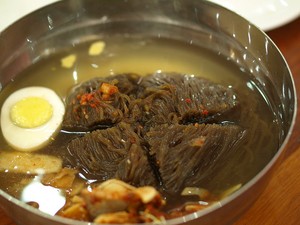Not only are you always within minutes of a restaurant anywhere in all Korean towns and cities, you don’t even have to move from where you are to get a meal. If you can describe the location you are at sufficiently enough in Korean, then you can probably get a local restaurant to deliver food to you. This is inclusive of all areas accessible my a small motorcycle.

People in recreational areas such as the riverside parks along the river will often find a restaurant menu pinned to a pillar or park bench, call it and get food delivered to them, at no extra cost. If a road heads up a mountain, and you’re hungry at the top, then, within reason, you can probably get some food delivered to you. One of the unique perks of Korea is this fantastic level of service which operates on a whole other level.
Types of Food Delivery
China food adopted from Koreans
 Jjajangmyeon(blackbean noodles) is one of the most popular dishes in South Korea. It consists of wheat noodles served with a black and sweet sauce called chunjang, made from roasted soybean, thickened with cornstarch and sweetened with caramel. The sauce can be prepared in many ways: the vegetarian version is prepared with carrots, cucumber, courgettes, onion and other vegetables while the non-vegetarian version also include pork, beef or seafood like squid and shrimps but not fish. The taste is very rich and the contrast of flavours is enjoyable. The thickness of sauce (due to the starch) are a perfect match for the chewy noodles. Pickled radish and raw onion are the selective side dishes for Jjajangmyeon and are meant to refresh your palate.
Jjajangmyeon(blackbean noodles) is one of the most popular dishes in South Korea. It consists of wheat noodles served with a black and sweet sauce called chunjang, made from roasted soybean, thickened with cornstarch and sweetened with caramel. The sauce can be prepared in many ways: the vegetarian version is prepared with carrots, cucumber, courgettes, onion and other vegetables while the non-vegetarian version also include pork, beef or seafood like squid and shrimps but not fish. The taste is very rich and the contrast of flavours is enjoyable. The thickness of sauce (due to the starch) are a perfect match for the chewy noodles. Pickled radish and raw onion are the selective side dishes for Jjajangmyeon and are meant to refresh your palate.
The origin of this dish are from China, but there are many differences. The Chinese version is more simple, including usually just pork, bean paste and sliced cucumber and the sauce is salty. After Jjajangmyeon was introduced to Korea, it was modified according to Korean taste and it was served for special occasions like weddings or birthdays. Things have changed in the last 30 years and it has become a casual dish. You can find many Jjangmyeon shops all over Korea and it can be ordered and delivered at home. After ordered it you will receive it within 30 minutes and after have consumed it, you can leave the bowl and cutlery outside of your step door for the delivery guy to take it back. Of course Jjajangmyeon is also available in instant packet in every convenience store.

Jjampong(noodles in spicy seafood broth) it’s a dish that was originally created in China but that has been adapted in Korea and that has become a very popular dish as much as Jjajangmyeon . As Jjajangmyeon, it is reasonably cheap and filling, making it a perfect meal for students. It is usually served in Chinese restaurants in Korea as well as take away and the funny thing is that if you are outside Korea, you will find this dish mostly in Korean restaurants and not in Chinese ones.
Jjampong consists in a stew of seafood such as shrimps, octopus or sea shells cooked together with vegetables and served with wheat noodles. Vegetables include green onion, carrots, ginger, cabbage and mushrooms. The peculiar thing about this dish is that the recipe is very flexible and the ingredients can change a lot according to their availability and to the country and it can also include meat. When I was in Canada, I tried a Jjampong prepared using squids, shrimps, octopus and clams as seafood and sliced pork as meat. The vegetables used were mushrooms, spinach, onion, green peppers and carrots. The spiciness to the dish was given by the red pepper flakes added.
Korean Fried Chicken
 Korean fried chicken or seasoned chicken(yangnyeom chicken) is a fried chicken dish prepared in a Korean style. It is consumed as a meal, fast food at bars, or as an after meal snack in Korea. Korean fried chicken differs from typical American fried chicken by being fried twice. This results in the skin being crunchier and less greasy. Furthermore, Korean-style chicken is not characterized by the crags and crusty nubs associated with American fried chicken as described by Julia Moskin of The New York Times as a "thin, crackly and almost transparent". The chickens are usually seasoned with spices, sugar, and salt, prior to and after being fried. Korean fried chicken restaurants commonly use small or medium sized chicken, in other words, younger chickens resulting in more tender meat. Pickled radishes, beer, and soju are often served with Korean fried chicken.
Korean fried chicken or seasoned chicken(yangnyeom chicken) is a fried chicken dish prepared in a Korean style. It is consumed as a meal, fast food at bars, or as an after meal snack in Korea. Korean fried chicken differs from typical American fried chicken by being fried twice. This results in the skin being crunchier and less greasy. Furthermore, Korean-style chicken is not characterized by the crags and crusty nubs associated with American fried chicken as described by Julia Moskin of The New York Times as a "thin, crackly and almost transparent". The chickens are usually seasoned with spices, sugar, and salt, prior to and after being fried. Korean fried chicken restaurants commonly use small or medium sized chicken, in other words, younger chickens resulting in more tender meat. Pickled radishes, beer, and soju are often served with Korean fried chicken.
Bossam
 Bossam is a type of ssam in Korean cuisine in which steamed or roasted pork is wrapped in a leaf vegetable such as red lettuce or sesame leaf, often accompanied by condiments known as ssamjang or gochujang. It can even be wrapped in a kimchi leaf. It is usually topped with raw or cooked garlic, onion, freshly made kimchi, saeujeot (pickled fermented shrimp), or other pickles. Bossam is a popular dish in Korea, and can also be served as an anju (side dish consumed while drinking alcoholic beverages). Bossam's origins are closely linked to kimchi. During the gimjang season, when large quantities of kimchi were made, noblemen gifted a pig to the kimchi makers to boost their spirit, as the process required hard work and dedication. The pig was steamed and eaten with freshly made kimchi. Pork meat is boiled in a broth that contains ginger and onions to reduce the smell. Bossam is often eaten with oyster on top of the meat, this variety is called gul bossam. Gul bossam restaurants also provide gamjatang (potato soup), which is traditionally eaten first.
Bossam is a type of ssam in Korean cuisine in which steamed or roasted pork is wrapped in a leaf vegetable such as red lettuce or sesame leaf, often accompanied by condiments known as ssamjang or gochujang. It can even be wrapped in a kimchi leaf. It is usually topped with raw or cooked garlic, onion, freshly made kimchi, saeujeot (pickled fermented shrimp), or other pickles. Bossam is a popular dish in Korea, and can also be served as an anju (side dish consumed while drinking alcoholic beverages). Bossam's origins are closely linked to kimchi. During the gimjang season, when large quantities of kimchi were made, noblemen gifted a pig to the kimchi makers to boost their spirit, as the process required hard work and dedication. The pig was steamed and eaten with freshly made kimchi. Pork meat is boiled in a broth that contains ginger and onions to reduce the smell. Bossam is often eaten with oyster on top of the meat, this variety is called gul bossam. Gul bossam restaurants also provide gamjatang (potato soup), which is traditionally eaten first.
Jokbal
 Jokbal is a Korean dish consisting of pigs' feet cooked with soy sauce and spices.[1] It is usually served in dark braising liquid, made from soy, ginger, garlic, rice wine. The hair is removed from pigs' feet and they are thoroughly washed. Leeks, garlic, ginger, cheongju (rice wine) and water are brought to a boil. The pigs' feet are added, brought back to a boil and then simmered until tender. Then additional water, sugar and soy sauce are poured into the pot and the contents are slowly stirred. Once the jokbal is fully cooked, bones are removed, and the meat is cut into thick slices. It is then served with fermented shrimp sauce called saeujeot.As jokbal is usually shared with several other diners, it is usually served in large portions on a platter. Due to its unique greasiness and strong flavor, jokbal is eaten like other Korean grilled meats - wrapped in lettuce with other vegetables by hand before it is eaten. As jokbal is considered an anju, it is often eaten with soju as well as other anjus such as Bindaetteok. Full with gelatins, jokbal is said to be good for skin and preventing wrinkles. The amino acid of methionine in pork is known to detoxicate alcohol, and prevents hangovers. It is also considered good for the detoxication of toxins due to silicosis and heavy metal poisoning.
Jokbal is a Korean dish consisting of pigs' feet cooked with soy sauce and spices.[1] It is usually served in dark braising liquid, made from soy, ginger, garlic, rice wine. The hair is removed from pigs' feet and they are thoroughly washed. Leeks, garlic, ginger, cheongju (rice wine) and water are brought to a boil. The pigs' feet are added, brought back to a boil and then simmered until tender. Then additional water, sugar and soy sauce are poured into the pot and the contents are slowly stirred. Once the jokbal is fully cooked, bones are removed, and the meat is cut into thick slices. It is then served with fermented shrimp sauce called saeujeot.As jokbal is usually shared with several other diners, it is usually served in large portions on a platter. Due to its unique greasiness and strong flavor, jokbal is eaten like other Korean grilled meats - wrapped in lettuce with other vegetables by hand before it is eaten. As jokbal is considered an anju, it is often eaten with soju as well as other anjus such as Bindaetteok. Full with gelatins, jokbal is said to be good for skin and preventing wrinkles. The amino acid of methionine in pork is known to detoxicate alcohol, and prevents hangovers. It is also considered good for the detoxication of toxins due to silicosis and heavy metal poisoning.
Naengmyeon
 Naengmyeon is a Korean noodle dish of long and thin handmade noodles made from the flour and starch of various ingredients: buckwheat, potatoes, sweet potatoes,naengmyun made with the starch from arrowroot (darker color and chewier than buckwheat noodles), and kudzu. Varieties with ingredients such as seaweed and green tea are available. According to the 19th century documents of Dongguksesigi, it has been made since the Joseon Dynasty. Originally a delicacy in northern Korea, especially in the cities of Pyongyang and Hamhung in North Korea, raengmyeon became widely popular throughout Korea after the Korean War. Naengmyeon is served in a large stainless bowl with a tangy iced broth, julienned cucumbers, slices of Korean pear, and either a boiled egg or slices of cold boiled beef or both. Spicy mustard sauce (or Mustard oil) and vinegar are often added before consumption. Traditionally, the long noodles would be eaten without cutting, as they symbolized longevity of life and good health, but servers at restaurants usually ask if the noodles should be cut prior to eating, and use scissors to cut the noodles.
Naengmyeon is a Korean noodle dish of long and thin handmade noodles made from the flour and starch of various ingredients: buckwheat, potatoes, sweet potatoes,naengmyun made with the starch from arrowroot (darker color and chewier than buckwheat noodles), and kudzu. Varieties with ingredients such as seaweed and green tea are available. According to the 19th century documents of Dongguksesigi, it has been made since the Joseon Dynasty. Originally a delicacy in northern Korea, especially in the cities of Pyongyang and Hamhung in North Korea, raengmyeon became widely popular throughout Korea after the Korean War. Naengmyeon is served in a large stainless bowl with a tangy iced broth, julienned cucumbers, slices of Korean pear, and either a boiled egg or slices of cold boiled beef or both. Spicy mustard sauce (or Mustard oil) and vinegar are often added before consumption. Traditionally, the long noodles would be eaten without cutting, as they symbolized longevity of life and good health, but servers at restaurants usually ask if the noodles should be cut prior to eating, and use scissors to cut the noodles.
The two main varieties of naengmyeon are mul naengmyeon and bibim naengmyeon. The former is served as a cold soup with the noodles contained in broth made from beef, chicken or dongchimi. The latter is served with a spicy dressing made primarily from gochujang (red chili paste) and eaten all mixed. In the case of bibim naengmyeon, a bowl of the soup broth used in mul naengmyeon or plain broth from the boiled noodles itself are often served on the side. Mul naengmyeon originates from Pyongyang. Pyongyang naengmyeon is mainly made from buckwheat and the broth of beef or pheasant. It also uses dongchimi broth or a mixture of it, while adding the sliced pieces of the radish to the dish. Vinegar, mustard oil (provided on request at most restaurants) and sugar is added according to taste before eating.
A version of bibim naengmyeon originates from Hamhung, the hoe naengmyeon. Hoe naengmyeon is bibim naengmyeon with additional marinated raw fish (hoe), usually skate. It is eaten with the spicy gochujang dressing and other ingredients all mixed. Vinegar, sugar, haszing duu, and sometimes sesame oil is added according to taste. The noodles of Hamhung naengmyeon are usually made from potato or sweet potato starch, so the noodles are very chewy in texture compared to those of Pyongyang naengmyeon.
Another variety of naengmyeon is yeolmu naengmyeon which is served with yeolmu kimchi.
Instant naengmyeon noodles are available, with the soup broth prepackaged with the noodles. A clear plastic package of mustard oil is often supplied.
And Others...
Even Pizza Hut, McDonalds and all other global fast food chains have a fleet of small delivery bikes. Often there is a minimum order price of 7000 won (about $7) for delivery. It does not bode well for anybody like me with habitually lazy patterns who wants to lose weight but can’t resist picking up the phone to get something delivered to the door.

Log in to write a comment